Environmental Impact: GHG Emissions from Oil and Gas in Canada
VerifiedAdded on 2023/05/29
|6
|1883
|398
Report
AI Summary
This report provides a detailed analysis of greenhouse gas (GHG) emissions from the oil and gas industries in Canada, highlighting the significant increase in emissions from 1990 to 2016. The report focuses on the role of British Columbia (BC), a major producer of oil and gas, and its contribution to national emissions. It examines the key GHGs emitted, including carbon dioxide, methane, sulfur dioxide, and nitrous oxide, and their impact on climate change. The report discusses the challenges BC faces in meeting emission reduction targets, the role of fracking, and the development of climate action plans. It also compares emission trends across different provinces and territories, offering insights into the environmental and policy implications of GHG emissions from the oil and gas sector. The analysis draws on various sources, including government statistics and academic research, to provide a comprehensive overview of the issue.
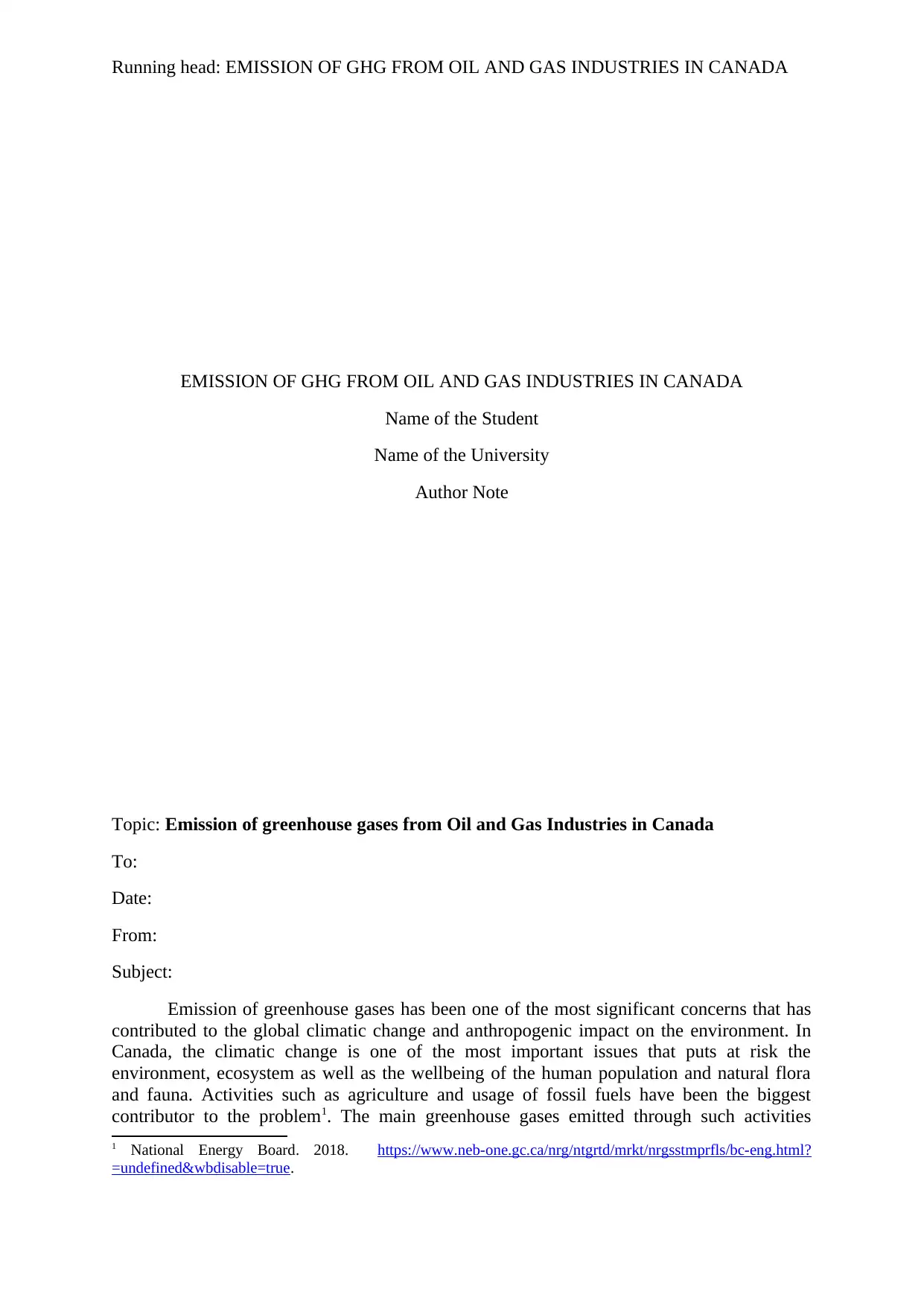
Running head: EMISSION OF GHG FROM OIL AND GAS INDUSTRIES IN CANADA
EMISSION OF GHG FROM OIL AND GAS INDUSTRIES IN CANADA
Name of the Student
Name of the University
Author Note
Topic: Emission of greenhouse gases from Oil and Gas Industries in Canada
To:
Date:
From:
Subject:
Emission of greenhouse gases has been one of the most significant concerns that has
contributed to the global climatic change and anthropogenic impact on the environment. In
Canada, the climatic change is one of the most important issues that puts at risk the
environment, ecosystem as well as the wellbeing of the human population and natural flora
and fauna. Activities such as agriculture and usage of fossil fuels have been the biggest
contributor to the problem1. The main greenhouse gases emitted through such activities
1 National Energy Board. 2018. https://www.neb-one.gc.ca/nrg/ntgrtd/mrkt/nrgsstmprfls/bc-eng.html?
=undefined&wbdisable=true.
EMISSION OF GHG FROM OIL AND GAS INDUSTRIES IN CANADA
Name of the Student
Name of the University
Author Note
Topic: Emission of greenhouse gases from Oil and Gas Industries in Canada
To:
Date:
From:
Subject:
Emission of greenhouse gases has been one of the most significant concerns that has
contributed to the global climatic change and anthropogenic impact on the environment. In
Canada, the climatic change is one of the most important issues that puts at risk the
environment, ecosystem as well as the wellbeing of the human population and natural flora
and fauna. Activities such as agriculture and usage of fossil fuels have been the biggest
contributor to the problem1. The main greenhouse gases emitted through such activities
1 National Energy Board. 2018. https://www.neb-one.gc.ca/nrg/ntgrtd/mrkt/nrgsstmprfls/bc-eng.html?
=undefined&wbdisable=true.
Paraphrase This Document
Need a fresh take? Get an instant paraphrase of this document with our AI Paraphraser
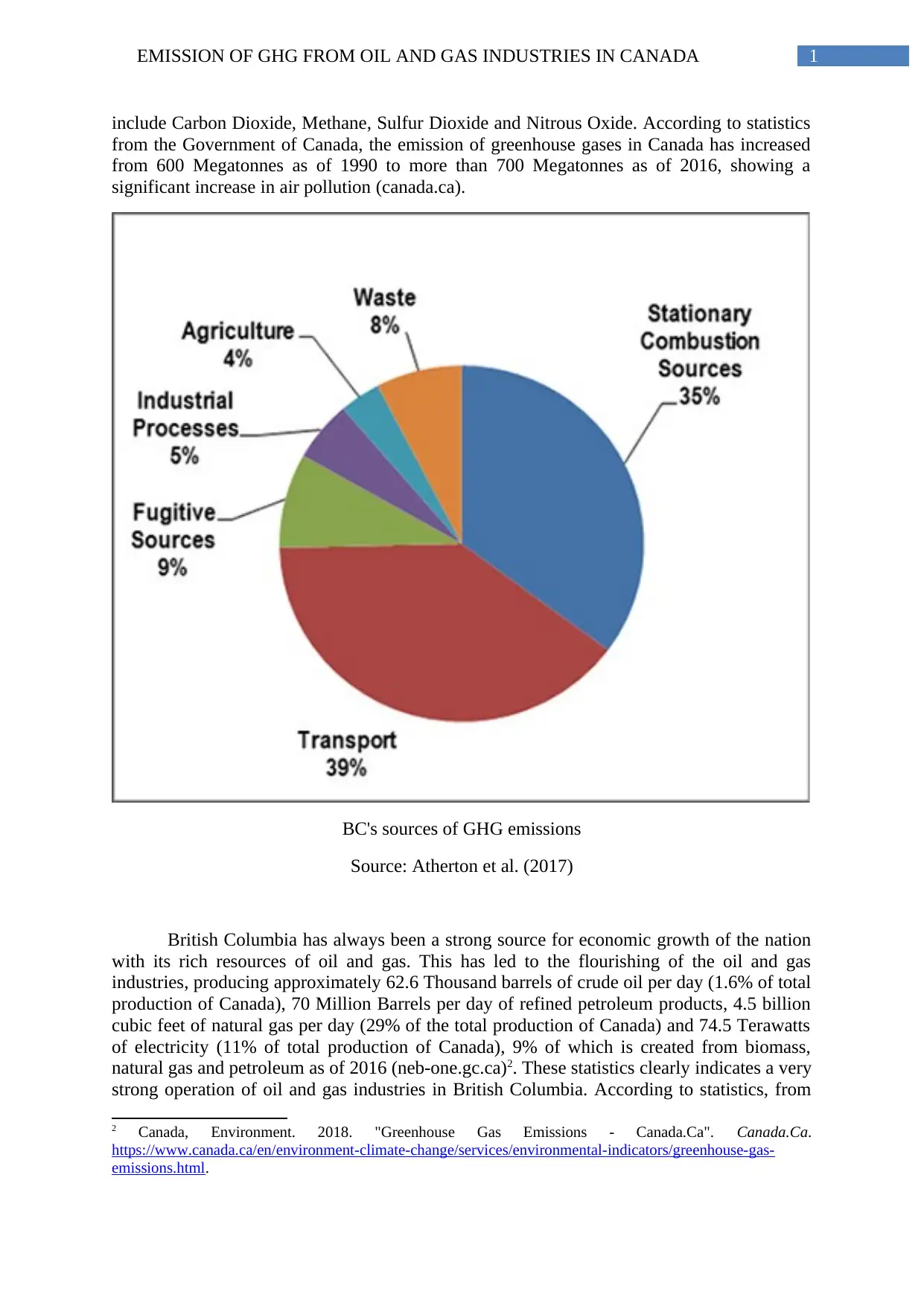
1EMISSION OF GHG FROM OIL AND GAS INDUSTRIES IN CANADA
include Carbon Dioxide, Methane, Sulfur Dioxide and Nitrous Oxide. According to statistics
from the Government of Canada, the emission of greenhouse gases in Canada has increased
from 600 Megatonnes as of 1990 to more than 700 Megatonnes as of 2016, showing a
significant increase in air pollution (canada.ca).
BC's sources of GHG emissions
Source: Atherton et al. (2017)
British Columbia has always been a strong source for economic growth of the nation
with its rich resources of oil and gas. This has led to the flourishing of the oil and gas
industries, producing approximately 62.6 Thousand barrels of crude oil per day (1.6% of total
production of Canada), 70 Million Barrels per day of refined petroleum products, 4.5 billion
cubic feet of natural gas per day (29% of the total production of Canada) and 74.5 Terawatts
of electricity (11% of total production of Canada), 9% of which is created from biomass,
natural gas and petroleum as of 2016 (neb-one.gc.ca)2. These statistics clearly indicates a very
strong operation of oil and gas industries in British Columbia. According to statistics, from
2 Canada, Environment. 2018. "Greenhouse Gas Emissions - Canada.Ca". Canada.Ca.
https://www.canada.ca/en/environment-climate-change/services/environmental-indicators/greenhouse-gas-
emissions.html.
include Carbon Dioxide, Methane, Sulfur Dioxide and Nitrous Oxide. According to statistics
from the Government of Canada, the emission of greenhouse gases in Canada has increased
from 600 Megatonnes as of 1990 to more than 700 Megatonnes as of 2016, showing a
significant increase in air pollution (canada.ca).
BC's sources of GHG emissions
Source: Atherton et al. (2017)
British Columbia has always been a strong source for economic growth of the nation
with its rich resources of oil and gas. This has led to the flourishing of the oil and gas
industries, producing approximately 62.6 Thousand barrels of crude oil per day (1.6% of total
production of Canada), 70 Million Barrels per day of refined petroleum products, 4.5 billion
cubic feet of natural gas per day (29% of the total production of Canada) and 74.5 Terawatts
of electricity (11% of total production of Canada), 9% of which is created from biomass,
natural gas and petroleum as of 2016 (neb-one.gc.ca)2. These statistics clearly indicates a very
strong operation of oil and gas industries in British Columbia. According to statistics, from
2 Canada, Environment. 2018. "Greenhouse Gas Emissions - Canada.Ca". Canada.Ca.
https://www.canada.ca/en/environment-climate-change/services/environmental-indicators/greenhouse-gas-
emissions.html.
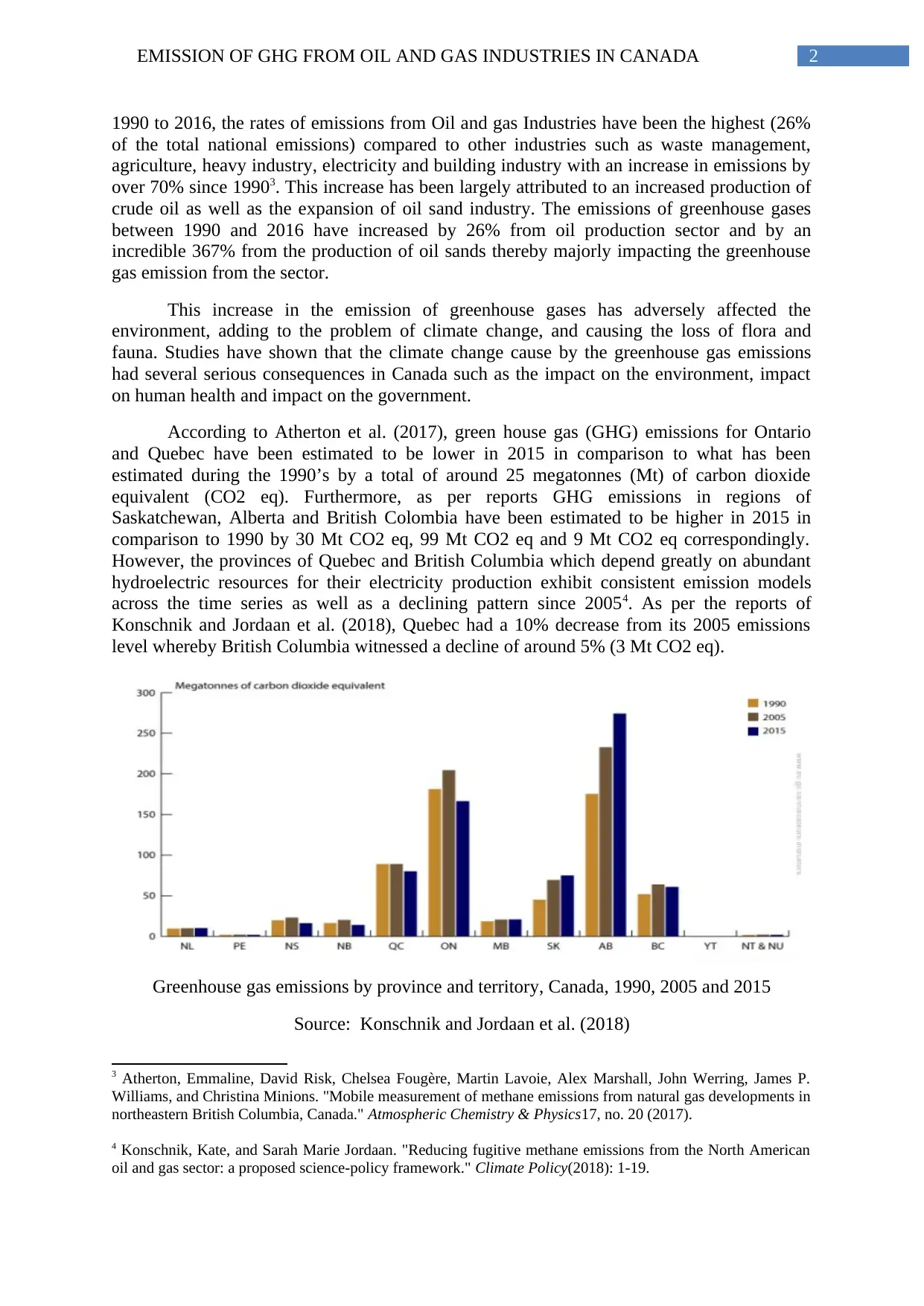
2EMISSION OF GHG FROM OIL AND GAS INDUSTRIES IN CANADA
1990 to 2016, the rates of emissions from Oil and gas Industries have been the highest (26%
of the total national emissions) compared to other industries such as waste management,
agriculture, heavy industry, electricity and building industry with an increase in emissions by
over 70% since 19903. This increase has been largely attributed to an increased production of
crude oil as well as the expansion of oil sand industry. The emissions of greenhouse gases
between 1990 and 2016 have increased by 26% from oil production sector and by an
incredible 367% from the production of oil sands thereby majorly impacting the greenhouse
gas emission from the sector.
This increase in the emission of greenhouse gases has adversely affected the
environment, adding to the problem of climate change, and causing the loss of flora and
fauna. Studies have shown that the climate change cause by the greenhouse gas emissions
had several serious consequences in Canada such as the impact on the environment, impact
on human health and impact on the government.
According to Atherton et al. (2017), green house gas (GHG) emissions for Ontario
and Quebec have been estimated to be lower in 2015 in comparison to what has been
estimated during the 1990’s by a total of around 25 megatonnes (Mt) of carbon dioxide
equivalent (CO2 eq). Furthermore, as per reports GHG emissions in regions of
Saskatchewan, Alberta and British Colombia have been estimated to be higher in 2015 in
comparison to 1990 by 30 Mt CO2 eq, 99 Mt CO2 eq and 9 Mt CO2 eq correspondingly.
However, the provinces of Quebec and British Columbia which depend greatly on abundant
hydroelectric resources for their electricity production exhibit consistent emission models
across the time series as well as a declining pattern since 20054. As per the reports of
Konschnik and Jordaan et al. (2018), Quebec had a 10% decrease from its 2005 emissions
level whereby British Columbia witnessed a decline of around 5% (3 Mt CO2 eq).
Greenhouse gas emissions by province and territory, Canada, 1990, 2005 and 2015
Source: Konschnik and Jordaan et al. (2018)
3 Atherton, Emmaline, David Risk, Chelsea Fougère, Martin Lavoie, Alex Marshall, John Werring, James P.
Williams, and Christina Minions. "Mobile measurement of methane emissions from natural gas developments in
northeastern British Columbia, Canada." Atmospheric Chemistry & Physics17, no. 20 (2017).
4 Konschnik, Kate, and Sarah Marie Jordaan. "Reducing fugitive methane emissions from the North American
oil and gas sector: a proposed science-policy framework." Climate Policy(2018): 1-19.
1990 to 2016, the rates of emissions from Oil and gas Industries have been the highest (26%
of the total national emissions) compared to other industries such as waste management,
agriculture, heavy industry, electricity and building industry with an increase in emissions by
over 70% since 19903. This increase has been largely attributed to an increased production of
crude oil as well as the expansion of oil sand industry. The emissions of greenhouse gases
between 1990 and 2016 have increased by 26% from oil production sector and by an
incredible 367% from the production of oil sands thereby majorly impacting the greenhouse
gas emission from the sector.
This increase in the emission of greenhouse gases has adversely affected the
environment, adding to the problem of climate change, and causing the loss of flora and
fauna. Studies have shown that the climate change cause by the greenhouse gas emissions
had several serious consequences in Canada such as the impact on the environment, impact
on human health and impact on the government.
According to Atherton et al. (2017), green house gas (GHG) emissions for Ontario
and Quebec have been estimated to be lower in 2015 in comparison to what has been
estimated during the 1990’s by a total of around 25 megatonnes (Mt) of carbon dioxide
equivalent (CO2 eq). Furthermore, as per reports GHG emissions in regions of
Saskatchewan, Alberta and British Colombia have been estimated to be higher in 2015 in
comparison to 1990 by 30 Mt CO2 eq, 99 Mt CO2 eq and 9 Mt CO2 eq correspondingly.
However, the provinces of Quebec and British Columbia which depend greatly on abundant
hydroelectric resources for their electricity production exhibit consistent emission models
across the time series as well as a declining pattern since 20054. As per the reports of
Konschnik and Jordaan et al. (2018), Quebec had a 10% decrease from its 2005 emissions
level whereby British Columbia witnessed a decline of around 5% (3 Mt CO2 eq).
Greenhouse gas emissions by province and territory, Canada, 1990, 2005 and 2015
Source: Konschnik and Jordaan et al. (2018)
3 Atherton, Emmaline, David Risk, Chelsea Fougère, Martin Lavoie, Alex Marshall, John Werring, James P.
Williams, and Christina Minions. "Mobile measurement of methane emissions from natural gas developments in
northeastern British Columbia, Canada." Atmospheric Chemistry & Physics17, no. 20 (2017).
4 Konschnik, Kate, and Sarah Marie Jordaan. "Reducing fugitive methane emissions from the North American
oil and gas sector: a proposed science-policy framework." Climate Policy(2018): 1-19.
⊘ This is a preview!⊘
Do you want full access?
Subscribe today to unlock all pages.

Trusted by 1+ million students worldwide
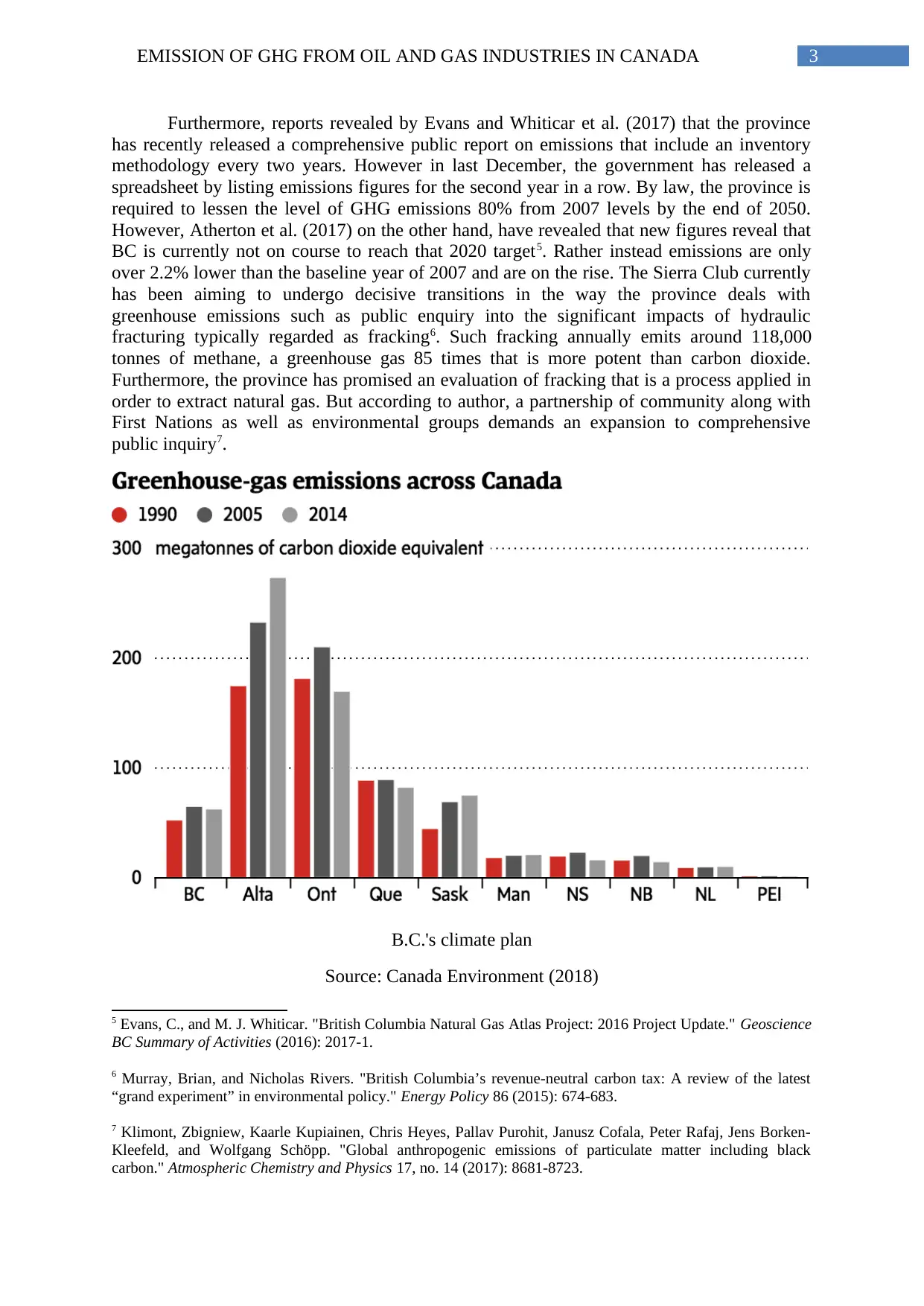
3EMISSION OF GHG FROM OIL AND GAS INDUSTRIES IN CANADA
Furthermore, reports revealed by Evans and Whiticar et al. (2017) that the province
has recently released a comprehensive public report on emissions that include an inventory
methodology every two years. However in last December, the government has released a
spreadsheet by listing emissions figures for the second year in a row. By law, the province is
required to lessen the level of GHG emissions 80% from 2007 levels by the end of 2050.
However, Atherton et al. (2017) on the other hand, have revealed that new figures reveal that
BC is currently not on course to reach that 2020 target5. Rather instead emissions are only
over 2.2% lower than the baseline year of 2007 and are on the rise. The Sierra Club currently
has been aiming to undergo decisive transitions in the way the province deals with
greenhouse emissions such as public enquiry into the significant impacts of hydraulic
fracturing typically regarded as fracking6. Such fracking annually emits around 118,000
tonnes of methane, a greenhouse gas 85 times that is more potent than carbon dioxide.
Furthermore, the province has promised an evaluation of fracking that is a process applied in
order to extract natural gas. But according to author, a partnership of community along with
First Nations as well as environmental groups demands an expansion to comprehensive
public inquiry7.
B.C.'s climate plan
Source: Canada Environment (2018)
5 Evans, C., and M. J. Whiticar. "British Columbia Natural Gas Atlas Project: 2016 Project Update." Geoscience
BC Summary of Activities (2016): 2017-1.
6 Murray, Brian, and Nicholas Rivers. "British Columbia’s revenue-neutral carbon tax: A review of the latest
“grand experiment” in environmental policy." Energy Policy 86 (2015): 674-683.
7 Klimont, Zbigniew, Kaarle Kupiainen, Chris Heyes, Pallav Purohit, Janusz Cofala, Peter Rafaj, Jens Borken-
Kleefeld, and Wolfgang Schöpp. "Global anthropogenic emissions of particulate matter including black
carbon." Atmospheric Chemistry and Physics 17, no. 14 (2017): 8681-8723.
Furthermore, reports revealed by Evans and Whiticar et al. (2017) that the province
has recently released a comprehensive public report on emissions that include an inventory
methodology every two years. However in last December, the government has released a
spreadsheet by listing emissions figures for the second year in a row. By law, the province is
required to lessen the level of GHG emissions 80% from 2007 levels by the end of 2050.
However, Atherton et al. (2017) on the other hand, have revealed that new figures reveal that
BC is currently not on course to reach that 2020 target5. Rather instead emissions are only
over 2.2% lower than the baseline year of 2007 and are on the rise. The Sierra Club currently
has been aiming to undergo decisive transitions in the way the province deals with
greenhouse emissions such as public enquiry into the significant impacts of hydraulic
fracturing typically regarded as fracking6. Such fracking annually emits around 118,000
tonnes of methane, a greenhouse gas 85 times that is more potent than carbon dioxide.
Furthermore, the province has promised an evaluation of fracking that is a process applied in
order to extract natural gas. But according to author, a partnership of community along with
First Nations as well as environmental groups demands an expansion to comprehensive
public inquiry7.
B.C.'s climate plan
Source: Canada Environment (2018)
5 Evans, C., and M. J. Whiticar. "British Columbia Natural Gas Atlas Project: 2016 Project Update." Geoscience
BC Summary of Activities (2016): 2017-1.
6 Murray, Brian, and Nicholas Rivers. "British Columbia’s revenue-neutral carbon tax: A review of the latest
“grand experiment” in environmental policy." Energy Policy 86 (2015): 674-683.
7 Klimont, Zbigniew, Kaarle Kupiainen, Chris Heyes, Pallav Purohit, Janusz Cofala, Peter Rafaj, Jens Borken-
Kleefeld, and Wolfgang Schöpp. "Global anthropogenic emissions of particulate matter including black
carbon." Atmospheric Chemistry and Physics 17, no. 14 (2017): 8681-8723.
Paraphrase This Document
Need a fresh take? Get an instant paraphrase of this document with our AI Paraphraser

4EMISSION OF GHG FROM OIL AND GAS INDUSTRIES IN CANADA
As per the reports of Rivers, Nicholas, and Brandon Schaufele et al (2017), new
liquefied natural gas (LNG) terminal would tend to increase BC’s domestic GHG emissions
Furthermore, the GHG emissions from LNG Canada emerge from the gas supply chain such
as fracking as well as transportation along with the liquefaction facility itself8. However the
problem for BC lies on the fact that the province is in great need to be on the pathway of
lessening its level of emissions.
The BC government is thus developing an advanced Climate Action Plan aimed for
2018 whereby the smaller Woodfibre LNG plant could be involved into newly developed
climate plan. Furthermore, the new BC government has identified this new legislated GHG
targets and would permit BC economy-wide emissions of around 39 Mt in 2030 declining to
almost 26 Mt in 2040 and 13 Mt in 2050. The plan of concentrating emission of GHG will
involve wide range of British Columbians who will be involved in the procedure and will
help the government by underlining Zero Emission Vehicles Zero emission vehicles (ZEVs)
to discover greater number of benefits. Furthermore, support for clean fuels in vehicles is
another less complex way to take transportation cleaner and help the government to
successfully reduce emission of GHG.
8 Rivers, Nicholas, and Brandon Schaufele. "Salience of carbon taxes in the gasoline market." Journal of
Environmental Economics and Management 74 (2015): 23-36.
As per the reports of Rivers, Nicholas, and Brandon Schaufele et al (2017), new
liquefied natural gas (LNG) terminal would tend to increase BC’s domestic GHG emissions
Furthermore, the GHG emissions from LNG Canada emerge from the gas supply chain such
as fracking as well as transportation along with the liquefaction facility itself8. However the
problem for BC lies on the fact that the province is in great need to be on the pathway of
lessening its level of emissions.
The BC government is thus developing an advanced Climate Action Plan aimed for
2018 whereby the smaller Woodfibre LNG plant could be involved into newly developed
climate plan. Furthermore, the new BC government has identified this new legislated GHG
targets and would permit BC economy-wide emissions of around 39 Mt in 2030 declining to
almost 26 Mt in 2040 and 13 Mt in 2050. The plan of concentrating emission of GHG will
involve wide range of British Columbians who will be involved in the procedure and will
help the government by underlining Zero Emission Vehicles Zero emission vehicles (ZEVs)
to discover greater number of benefits. Furthermore, support for clean fuels in vehicles is
another less complex way to take transportation cleaner and help the government to
successfully reduce emission of GHG.
8 Rivers, Nicholas, and Brandon Schaufele. "Salience of carbon taxes in the gasoline market." Journal of
Environmental Economics and Management 74 (2015): 23-36.
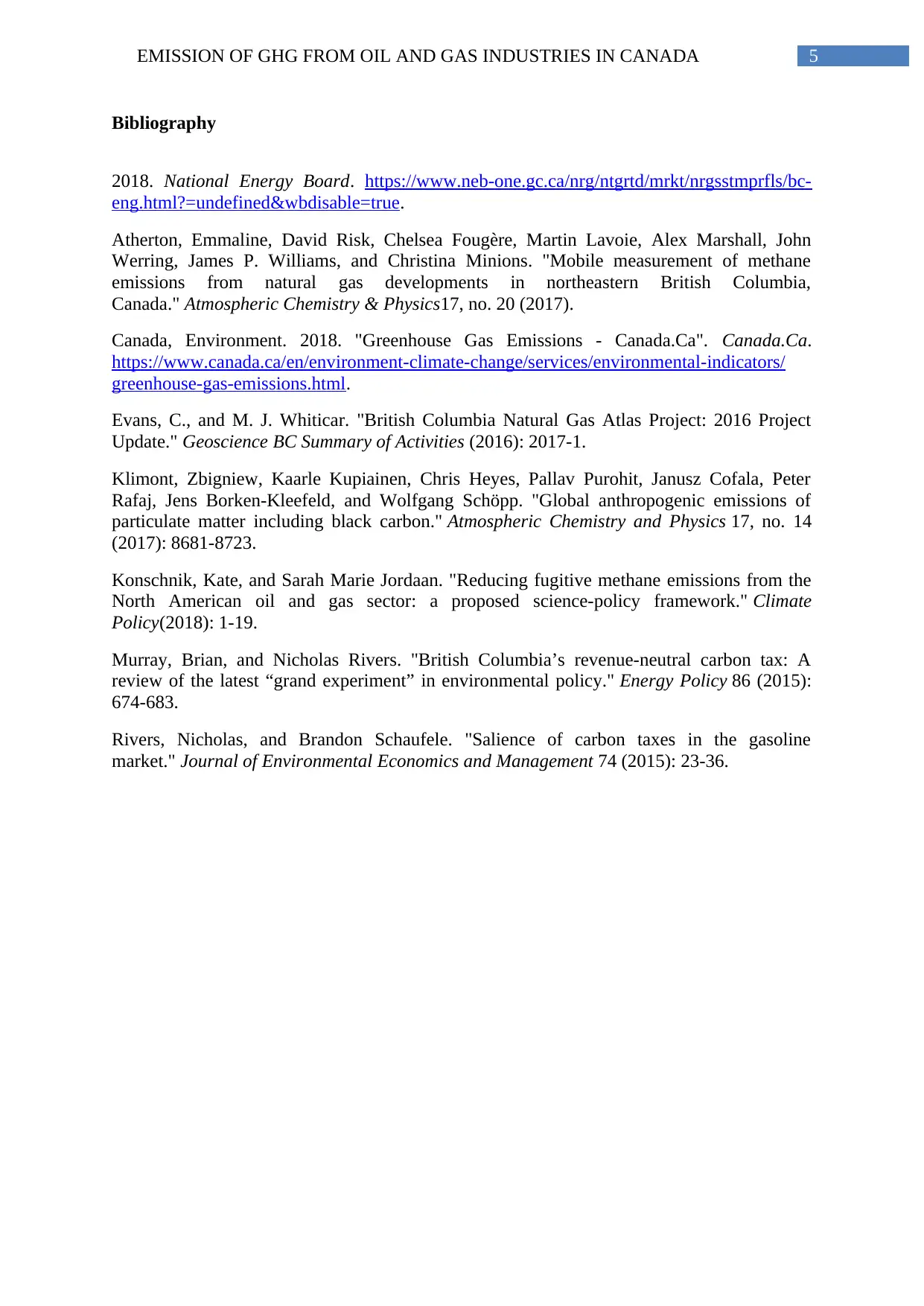
5EMISSION OF GHG FROM OIL AND GAS INDUSTRIES IN CANADA
Bibliography
2018. National Energy Board. https://www.neb-one.gc.ca/nrg/ntgrtd/mrkt/nrgsstmprfls/bc-
eng.html?=undefined&wbdisable=true.
Atherton, Emmaline, David Risk, Chelsea Fougère, Martin Lavoie, Alex Marshall, John
Werring, James P. Williams, and Christina Minions. "Mobile measurement of methane
emissions from natural gas developments in northeastern British Columbia,
Canada." Atmospheric Chemistry & Physics17, no. 20 (2017).
Canada, Environment. 2018. "Greenhouse Gas Emissions - Canada.Ca". Canada.Ca.
https://www.canada.ca/en/environment-climate-change/services/environmental-indicators/
greenhouse-gas-emissions.html.
Evans, C., and M. J. Whiticar. "British Columbia Natural Gas Atlas Project: 2016 Project
Update." Geoscience BC Summary of Activities (2016): 2017-1.
Klimont, Zbigniew, Kaarle Kupiainen, Chris Heyes, Pallav Purohit, Janusz Cofala, Peter
Rafaj, Jens Borken-Kleefeld, and Wolfgang Schöpp. "Global anthropogenic emissions of
particulate matter including black carbon." Atmospheric Chemistry and Physics 17, no. 14
(2017): 8681-8723.
Konschnik, Kate, and Sarah Marie Jordaan. "Reducing fugitive methane emissions from the
North American oil and gas sector: a proposed science-policy framework." Climate
Policy(2018): 1-19.
Murray, Brian, and Nicholas Rivers. "British Columbia’s revenue-neutral carbon tax: A
review of the latest “grand experiment” in environmental policy." Energy Policy 86 (2015):
674-683.
Rivers, Nicholas, and Brandon Schaufele. "Salience of carbon taxes in the gasoline
market." Journal of Environmental Economics and Management 74 (2015): 23-36.
Bibliography
2018. National Energy Board. https://www.neb-one.gc.ca/nrg/ntgrtd/mrkt/nrgsstmprfls/bc-
eng.html?=undefined&wbdisable=true.
Atherton, Emmaline, David Risk, Chelsea Fougère, Martin Lavoie, Alex Marshall, John
Werring, James P. Williams, and Christina Minions. "Mobile measurement of methane
emissions from natural gas developments in northeastern British Columbia,
Canada." Atmospheric Chemistry & Physics17, no. 20 (2017).
Canada, Environment. 2018. "Greenhouse Gas Emissions - Canada.Ca". Canada.Ca.
https://www.canada.ca/en/environment-climate-change/services/environmental-indicators/
greenhouse-gas-emissions.html.
Evans, C., and M. J. Whiticar. "British Columbia Natural Gas Atlas Project: 2016 Project
Update." Geoscience BC Summary of Activities (2016): 2017-1.
Klimont, Zbigniew, Kaarle Kupiainen, Chris Heyes, Pallav Purohit, Janusz Cofala, Peter
Rafaj, Jens Borken-Kleefeld, and Wolfgang Schöpp. "Global anthropogenic emissions of
particulate matter including black carbon." Atmospheric Chemistry and Physics 17, no. 14
(2017): 8681-8723.
Konschnik, Kate, and Sarah Marie Jordaan. "Reducing fugitive methane emissions from the
North American oil and gas sector: a proposed science-policy framework." Climate
Policy(2018): 1-19.
Murray, Brian, and Nicholas Rivers. "British Columbia’s revenue-neutral carbon tax: A
review of the latest “grand experiment” in environmental policy." Energy Policy 86 (2015):
674-683.
Rivers, Nicholas, and Brandon Schaufele. "Salience of carbon taxes in the gasoline
market." Journal of Environmental Economics and Management 74 (2015): 23-36.
⊘ This is a preview!⊘
Do you want full access?
Subscribe today to unlock all pages.

Trusted by 1+ million students worldwide
1 out of 6
Related Documents
Your All-in-One AI-Powered Toolkit for Academic Success.
+13062052269
info@desklib.com
Available 24*7 on WhatsApp / Email
![[object Object]](/_next/static/media/star-bottom.7253800d.svg)
Unlock your academic potential
Copyright © 2020–2026 A2Z Services. All Rights Reserved. Developed and managed by ZUCOL.





